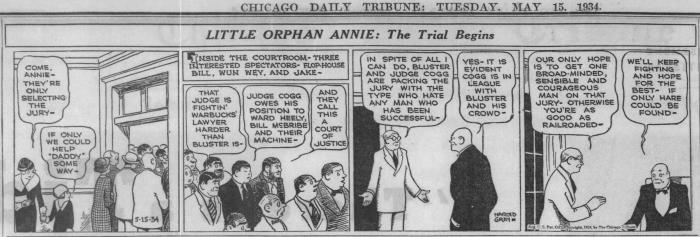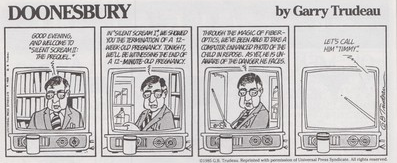Like Leslie Stahl after her MTG interview, I have been chastised for linking this article out to comics fans without any remarks as to some of the wayward assertions made by the author. After the original post I have included some fact-checking.
Original April 9, 2023 post:
What do Dilbert by Scott Adams, Non Sequitur by Wiley, Pogo by Walt Kelly, Little Orphan Annie by Harold Gray, Doonesbury by G. B. Trudeau, The Far Side by Gary Larson, The Yellow Kid by Richard F. Outcault and George B. Luks, Chester the Molester by Dwaine B. Tinsley, Calvin and Hobbes by Bill Watterson, Pearls Before Swine by Stephan Pastis, and Gasoline Alley by Frank King and Jim Scancarelli have in common?

They are all included in S. Flannagan’s list of “Most Controversial Comic Strip Moments” at Grunge.
… Yet comic strips and the cartoonists behind them have been known to cause controversy down the years. From career-destroying outbursts to strips that outraged readers, and from lawsuits to strips that just haven’t stood the test of time, comics have had their moments in history, to the delight or outrage of their readers.


April 11 edit to add some comments:
The Downfall of Dilbert
Strangely an article about “Controversial Comic Strip Moments” begins with an example that has no comic strip moment, rather a personal opinion made by a cartoonist not within his printed comic strip. While Adams has had the Dilbert comic strip comment on identity issues, and he has insinuated that those may have been the reason Lee Enterprises dropped the strip, it was his remarks on his podcast for which Dilbert was pulled from syndication.

And while the eyeballs reading his pay-per-view Dilbert Reborn is certainly many-fold fewer than the previously syndicated Dilbert, he remains a daily cartoonist so it hasn’t “effectively ended his career as a cartoonist.”
Two Non Sequitur Incidents
“In another incident in 2019, “Non Sequitur” was discontinued in one Pennsylvania newspaper after its publisher discovered that Wiley had hidden an “easter egg” in one of his comic strips…”
I’m sure Wiley Miller would have been overjoyed if it was just The Butler Eagle that dropped Non Sequitur over the faux pas, unfortunately hundreds of newspapers dropped the comic and it took years to claw back subscribers.
and
“…Wiley, earning a Ruben Award for Outstanding Cartoonist of the Year in 2013, the year that “Non Sequitur” was first syndicated.”
It’s Reuben Award, not”Ruben.” Non Sequitur debuted in 1992, 21 years before 2013.
Pogo Was Too Political
This account seems fine as far as it goes.

But probably should have included a mention of the “bunny (special) strips.”
Doonesbury Satirized The Anti-Abortion Lobby
Again – as far as it goes (and of all the Doonesbury controversies this is the one to highlight).
“In May 1985 six ‘Doonesbury’ strips were withdrawn from circulation by Universal Press Syndicate.” G. B. Trudeau acquiesced with the syndicate’s desire to pull the strips, the syndicate and the cartoonist discussed the matter and mutually agreed to not offer it to newspapers. The syndicate didn’t do any of it without the cartoonist’s permission.

That same month, late May 1985, those strips were on the newsstands in the June 10, 1985 issue of The New Republic and the strips were included in the 1986 Doonesbury collection That’s Doctor Sinatra, You Little Bimbo! So it isn’t like the strips disappeared and were never seen again.
Copyright Issues Killed The Yellow Kid
The timeline as described here is unclear and the character continued for a year and a half in both The New York World and The New York Journal after the copyright confusion. The World retained the Hogan’s Alley title while Outcault was allowed to continue the character with Hearst under another title.
It wasn’t copyright, it was apathy killed The Kid.
A Now-Unprintable Calvin and Hobbes
“As with the entirety of “Calvin and Hobbes,” the comic strip in question [see above] was syndicated years before the horrifying events of the Columbine Massacre in 1999, and prior to the perpetual incidents of school shootings that continue to plague the United States. It is doubtful that it would be published today.”
The strip was and is included in Calvin and Hobbes collections, including the recent Complete Calvin and Hobbes. It remains on the GoComics site. It is unknown if that Sunday strip is included in the current rotation of strips offered to markets outside the U.S. (anybody?). On the other hand the November 28, 1985 Calvin and Hobbes daily strip was replaced by half(?)/most(?) of the newspapers running it at the time and has never been reprinted since.

And now it’s your turn to correct what I have wrong.
feature image from The Far Side © Gary Larson
I feel our comics are one of our last hopes for freedom of press! I pray brave souls can continue to comment on controversial issues without fear of censorship. This is what makes America great and without freedom of expression, we are no better than a slave population under communist rule.
I’m sure there have been slave populations under other than communist rule.
The use of that term in place of “dictator” or “authoritarian” is how right-wingers such as nazis gain power as they seek to enslave their populations.
Oh, you heard the dog whistle too? It seems like they honestly can’t stop themselves.
I hate to break your heart, but the nazis were left-wing socialists
They have comic strips in Cuba…
Nazis as left wingers? Lmao history and political theory prove that false. I mean sure, they haven’t the word “socialist” in their name – just like North Korea has the word “democratic” in the long form name of their country.
But I digress. Hitler shut down all the labor unions when he took power. Nazi Germany was a far right state, as the USSR was far left.